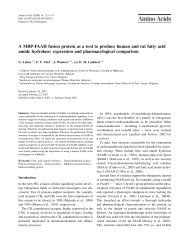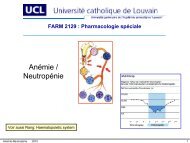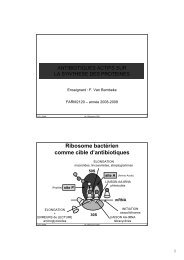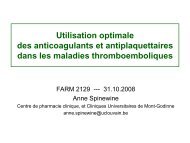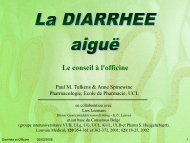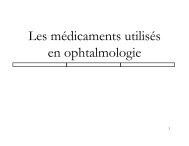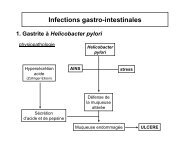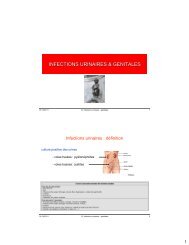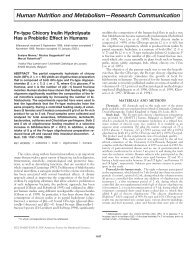Role of apoptosis for mouse liver growth regulation and tumor ...
Role of apoptosis for mouse liver growth regulation and tumor ...
Role of apoptosis for mouse liver growth regulation and tumor ...
Create successful ePaper yourself
Turn your PDF publications into a flip-book with our unique Google optimized e-Paper software.
34 W. Bursch et al. / Toxicology Letters 149 (2004) 25–35<br />
Inherent increase <strong>of</strong> <strong>apoptosis</strong> in <strong>liver</strong> <strong>tumor</strong>s: implications <strong>for</strong><br />
carcinogenesis <strong>and</strong> <strong>tumor</strong> regression. Hepatology 25 (4), 906–<br />
912.<br />
Hanigan, M.H., Winkler, M.L., Drinkwater, N.R., 1993. Induction<br />
<strong>of</strong> three histochemically distinct populations <strong>of</strong> hepatic foci in<br />
C57BL/6J mice. Carcinogenesis 14 (5), 1035–1040.<br />
Hasmall, S.C., Roberts, R.A., 1997. Hepatic ploidy, nuclearity,<br />
<strong>and</strong> distribution <strong>of</strong> DNA synthesis: a comparison <strong>of</strong><br />
nongenotoxic hepatocarcinogens with noncarcinogenic <strong>liver</strong><br />
mitogens. Toxicol. Appl. Pharmacol. 144 (2), 287–293.<br />
Hikita, H., Nuwaysir, E.F., Vaughan, J., Babcock, K., Haas, M.J.,<br />
Dragan, Y.P., Pitot, H.C., 1998. The effect <strong>of</strong> short-term fasting,<br />
phenobarbital <strong>and</strong> refeeding on apoptotic loss, cell replication<br />
<strong>and</strong> gene expression in rat <strong>liver</strong> during the promotion stage.<br />
Carcinogenesis 19 (8), 1417–1425.<br />
Huber, W.W., Grasl-Kraupp, B., Schulte-Hermann, R., 1996.<br />
Hepatocarcinogenic potential <strong>of</strong> di(2-ethylhexyl)phthalate in<br />
rodents <strong>and</strong> its implications on human risk. Crit. Rev. Toxicol.<br />
26 (4), 365–481.<br />
James, S.J., Muskhelishvili, L., 1994. Rates <strong>of</strong> <strong>apoptosis</strong> <strong>and</strong><br />
proliferation vary with caloric intake <strong>and</strong> may influence<br />
incidence <strong>of</strong> spontaneous hepatoma in C57BL/6J × C3H F1<br />
mice. Cancer Res. 54, 5508–5510.<br />
James, N.H., Roberts, R.A., 1996. Species differences in response<br />
to peroxisome proliferators correlate in vitro with induction<br />
<strong>of</strong> DNA synthesis rather than suppression <strong>of</strong> <strong>apoptosis</strong>.<br />
Carcinogenesis 17 (8), 1623–1632.<br />
James, N.H., Soames, A.R., Roberts, R.A., 1998. Suppression <strong>of</strong><br />
hepatocyte <strong>apoptosis</strong> <strong>and</strong> induction <strong>of</strong> DNA synthesis by the<br />
rat <strong>and</strong> <strong>mouse</strong> hepatocarcinogen diethylhexylphlathate (DEHP)<br />
<strong>and</strong> the <strong>mouse</strong> hepatocarcinogen 1,4-dichlorobenzene (DCB).<br />
Arch. Toxicol. 72 (12), 784–790.<br />
Kamendulis, L.M., Kolaja, K.L., Stevenson, D.E., Walborg Jr.,<br />
E.F., Klaunig, J.E., 2001. Comparative effects <strong>of</strong> dieldrin on<br />
hepatic ploidy, cell proliferation, <strong>and</strong> <strong>apoptosis</strong> in rodent <strong>liver</strong>.<br />
J. Toxicol. Environ. Health A 62 (2), 127–141.<br />
Kolaja, K.L., Bunting, K.A., Klaunig, J.E., 1996a. Inhibition<br />
<strong>of</strong> <strong>tumor</strong> promotion <strong>and</strong> hepatocellular <strong>growth</strong> by dietary<br />
restriction in mice. Carcinogenesis 17 (8), 1657–1664.<br />
Kolaja, K.L., Stevenson, D.E., Walborg Jr., E.F., Klaunig, J.E.,<br />
1996b. Selective dieldrin promotion <strong>of</strong> heptic focal lesions in<br />
mice. Carcinogenesis 17, 1243–1250.<br />
Kolaja, K.L., Stevenson, D.E., Walborg Jr., E.F., Klaunig,<br />
J.E., 1996c. Dose dependence <strong>of</strong> phenobarbital promotion <strong>of</strong><br />
preneoplastic hepatic lesions in F344 rats <strong>and</strong> B6C3F1 mice:<br />
effects on DNA synthesis <strong>and</strong> <strong>apoptosis</strong>. Carcinogenesis 17 (5),<br />
947–954.<br />
Kolaja, K.L., Stevenson, D.E., Johnson, J.T., Walborg Jr., E.F.,<br />
Klaunig, J.E., 1996d. Subchronic effects <strong>of</strong> dieldrin <strong>and</strong><br />
phenobarbital on hepatic DNA synthesis in mice <strong>and</strong> rats.<br />
Fundam. Appl. Toxicol. 29 (2), 219–228.<br />
Lee, G.H., 1997. Correlation between Bcl-2 expression<br />
<strong>and</strong> histopathology in diethyl-nitrosamine-induced <strong>mouse</strong><br />
hepatocellular <strong>tumor</strong>s. Am. J. Pathol. 151 (4), 957–961.<br />
Lee, G.H., 2000. Paradoxical effects <strong>of</strong> phenobarbital on <strong>mouse</strong><br />
hepatocarcinogenesis. Toxicol. Pathol. 28 (2), 215–225.<br />
Luebeck, G.E., Grasl-Kraupp, B., Timmermann-Trosiener, I.,<br />
Bursch, W., Schulte-Hermann, R., Moolgavkar, S.H., 1995.<br />
Growth kinetics <strong>of</strong> enzyme altered <strong>liver</strong> foci in rats treated<br />
with phenobarbital or -hexachlorocylohexane. Toxicol. Appl.<br />
Pharmacol. 130, 304–315.<br />
Luebeck, G.E., Buchmann, A., Stinchcombe, S., Moolgavkar, S.H.,<br />
Schwarz, M., 2000. Effects <strong>of</strong> 2,3,7,8-tetrachlorodibenzo-pdioxin<br />
on initiation <strong>and</strong> promotion <strong>of</strong> GST-P-positive foci in<br />
rat <strong>liver</strong>: a quantitative analysis <strong>of</strong> experimental data using a<br />
stochastic model. Toxicol. Appl. Pharmacol. 167 (1), 63–73.<br />
Maronpot, R.R., Boorman, G.A., 1996. The contribution <strong>of</strong> the<br />
<strong>mouse</strong> in hazard identification studies. Toxicol. Pathol. 24,<br />
726–731.<br />
Nims, R.W., Devor, D.E., Henneman, J.R., Lubet, R.A., 1987.<br />
Induction <strong>of</strong> alkoxyresorufin o-dealkylases, epoxide hydrolase,<br />
<strong>and</strong> <strong>liver</strong> weight gain: correlation with <strong>liver</strong> <strong>tumor</strong>-promoting<br />
potential in a series <strong>of</strong> barbiturates. Carcinogenesis 8 (1), 67–<br />
71.<br />
O<strong>liver</strong>, J.D., Roberts, R.A., 2002. Receptor-mediated hepatocarcinogenesis:<br />
role <strong>of</strong> hepatocyte proliferation <strong>and</strong> <strong>apoptosis</strong>.<br />
Pharmacol. Toxicol. 91 (1), 1–7.<br />
Parzefall, W., Kainzbauer, E., Hong-Min, Q., Chabicovsky, M.,<br />
Schulte-Hermann, R., 2002. Response <strong>of</strong> isolated hepatocytes<br />
from carcinogen sensitive (C3H) <strong>and</strong> insensitive mice to signals<br />
inducing replication or <strong>apoptosis</strong>. Arch. Toxicol. 76, 699–706.<br />
Pereira, M.A., 1993. Comparison in C3H <strong>and</strong> C3B6F1<br />
mice <strong>of</strong> the sensitivity to diethylnitrosamine-initiation <strong>and</strong><br />
phenobarbital-promotion to the extent <strong>of</strong> cell proliferation.<br />
Carcinogenesis 14 (2), 299–302.<br />
Pitot, H.C., Hikita, H., Dragan, Y., Sargent, L., Haas, M., 2000.<br />
Review article: the stages <strong>of</strong> gastrointestinal carcinogenesis—<br />
application <strong>of</strong> rodent models to human disease. Aliment.<br />
Pharmacol. Ther. 14 (Suppl 1), 153–160.<br />
S<strong>and</strong>ers, S., Thorgeirsson, S.S., 2000. Promotion <strong>of</strong> hepatocarcinogenesis<br />
by phenobarbital in c-myc/TGF-alpha transgenic<br />
mice. Mol. Carcinog. 28 (3), 168–173.<br />
Schulte-Hermann, R., 1974. Induction <strong>of</strong> <strong>liver</strong> <strong>growth</strong> by xenobiotic<br />
compounds <strong>and</strong> other stimuli. Crit. Rev. Toxicol. 3, 97–158.<br />
Schulte-Hermann, R., Ochs, H., Bursch, W., Parzefall, W., 1988.<br />
Quantitative structure-activity studies on effects <strong>of</strong> 16 different<br />
steroids on <strong>growth</strong> <strong>and</strong> monooxygenases <strong>of</strong> rat <strong>liver</strong>. Cancer<br />
Res. 48, 2462–2468.<br />
Schulte-Hermann, R., Timmermann-Trosiener, I., Barthel, G.,<br />
Bursch, W., 1990. DNA synthesis, <strong>apoptosis</strong>, <strong>and</strong> phenotypic<br />
expression as determinants <strong>of</strong> <strong>growth</strong> <strong>of</strong> altered foci in rat <strong>liver</strong><br />
during phenobarbital promotion. Cancer Res. 50, 5127–5135.<br />
Schwarz, M., Buchmann, A., Stinchcombe, S., Kalkuhl, A., Bock,<br />
K., 2000. Ah receptor lig<strong>and</strong>s <strong>and</strong> <strong>tumor</strong> promotion: survival<br />
<strong>of</strong> neoplastic cells. Toxicol. Lett. 112-113, 69–77.<br />
Stevenson, D.E., Walborg Jr., E.F., North, D.W., Sielken Jr., R.L,<br />
Ross, C.E., Wright, A.S., Xu, Y., Kamendulis, L.M., Klaunig,<br />
J.E., 1999. Monograph: reassessment <strong>of</strong> human cancer risk <strong>of</strong><br />
aldrin/dieldrin. Toxicol. Lett. 109 (3), 123–186.<br />
Tharappel, J.C., Lee, E.Y., Robertson, L.W., Spear, B.T., Glauert,<br />
H.P., 2002. Regulation <strong>of</strong> cell proliferation, <strong>apoptosis</strong>, <strong>and</strong><br />
transcription factor activities during the promotion <strong>of</strong> <strong>liver</strong><br />
carcinogenesis by polychlorinated biphenyls. Toxicol. Appl.<br />
Pharmacol. 179 (3), 172–184.



